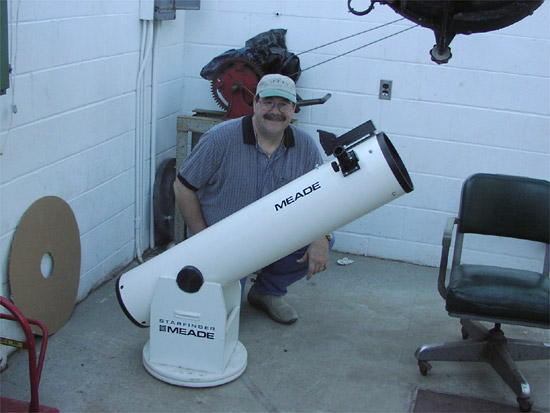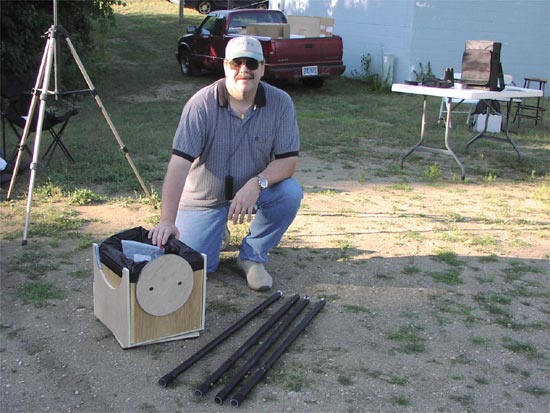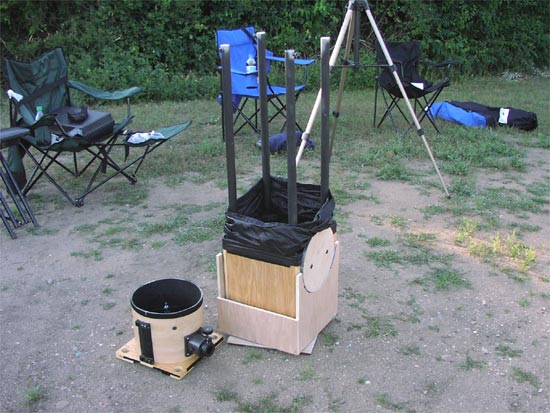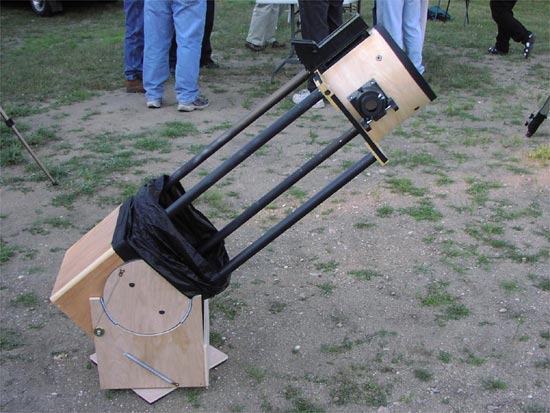

About 10 years ago I bought a Meade 8” Starfinder Dobsonian telescope, and for the better portion of that time it was my favorite scope. However, after ten years of carting the telescope to various observing sites and ten years of dew and bouncing around in the back seat of my car, the optical tube assembly was getting a bit worn and look its age. When I first got the scope I found that I had a very good primary mirror. The 8” f/6 was figured very well and was polished as good as they get from mass production mirrors. Mark Cray said that it was better than 1/12 wave error (whatever that means). He also said that the original mirror cell had to go, because it was completely closed up in the back and the mirror would take forever to cool down. Mark Cray sold me one of his mirror cells and the improvement in stable image quality was immediate. When I bought the scope, I told the salesman at Rider’s Hobby shop in Jackson, MI that I did not want the standard 8x30 finder scope; that a Telrad zero power reflex finder was what I wanted. I also talked him into throwing in the Messier Catalog finder charts for the Telrad as compensation for the fact that the store had been using the scope for demo purposes. John Kirchhoff (yes, the same... he used to work out in Jackson) agreed, and hoped I would be happy with my new scope.
The photo shows the original configuration of my scope before I rebuilt it into the “Kingfish 8.” I’ll explain the name later. Note that the scope shown is actually Lorna’s 8” Meade Starfinder that she stores at the observatory.

For a long time I have wanted to redo my scope and make it a little more portable. I looked at and studied a lot of different designs, from ultra-light weight to Sonotube designs. All of them had good points and drawbacks. The ultra-lights were very portable but not very sturdy and the full Sonotubes were sturdy but not very portable. If I could get the scope sized down to a 15” cube or smaller without losing any stability and not adding a lot of extra weight.... I would have something close to my goal. The 12.5” Red Scope that John Causland lets me use all the time was my biggest inspiration for the design I settled on.
The mirror box nests inside the rocker box and the secondary cage nests inside the mirror box and the truss tubes are separate. The whole scope (when collapsed) is 15”x15”x12” plus a 30” long bag containing telescoping truss tubes. I thought that I could make something similar to this. The 12.5” Red Scope had its main components made out of aluminum, I would be making mine out of plywood. Now, you must remember that I am no Bob Vila or Norm from the New Yankee Workshop and my knowledge and woodworking abilities are limited to minor repairs on existing items and the occasional prefabricated Sauder desk or bookcase. My tools are limited to a circular saw, a power drill, a skill saw, an orbital sander and a Black & Decker Workmate workbench, but I am always willing to try and my dad taught me a few things and I have enough confidence in my own abilities that I was reasonably sure I could do what I needed to do.
My first step was to decide on the type of wood and its thickness. I went to Fingerle Lumber and talked to a couple of sales consultants and they suggested either Maple or Red Oak. Both were hardwoods and both came in the 1/2 inch thickness I had decided on. I had already calculated that even with a couple of screwed up cuts, a half sheet would be plenty of wood for my needs. They had a half sheet of Red Oak in their leftovers bin and it was priced right and ready for my project, wasn’t that nice! Through conversations with others I had learned the Red Oak has very long grains and tends to splinter a lot when it’s cut with anything other than a very sharp saw blade, so I also bought a couple of new saw blades for my saws.
I had worked up some plans and decided that I would cut all the pieces of wood that I would need at one time and then assemble the whole thing. I decided not to try making 45 degree angles on all of my corners because I only had enough wood for a couple of screw ups and fancy cutting would increase that number substantially. My solution was something I had seen and done before, 1/2 inch quarter round molding glued to the edges of the plywood to form nicely rounded corners. I had also decided to use Sonotube for the secondary cage mounted to a piece of 1/2” plywood. Here was my first problem.
How do I cut a perfect 10 1/2” diameter round hole in my plywood to accommodate the 10” inside diameter Sonotube? I was also going to need the same size hole cut out of the bottom of my mirror box to accommodate the mirror cell.
The answer was a Router with a router compass attachment. This would give me two 10” diameter cut outs that would be used for my altitude bearings. Clayton Kessler was the first to volunteer his services and router to the rescue. (Thank you, Clay.) The next problem came when I realized the existing secondary four vane spider was going to be too small for the 10” Sonotube. (Meade makes their own Sonotubes.) The spider was designed for a tube that was 9 1/2” outside diameter and the connecting screws at the end of the vanes wouldn’t reach the outside of a 10” tube.
The solution was a type of “T” nut used in the prefabricated furniture that you buy and assemble yourself. The ones I used extended a 1/4” past the inside of my Sonotube and worked perfectly. While I was buying the “T” nuts, I also found some threaded inserts that looked perfect for attaching my 1 1/4” diameter aluminum truss tubes to the mirror box and secondary cage. That might have been my third little problem, but turned out to work better than I had hoped. In fact everything I tried on this project worked as planned or better.
I used wood grained contact paper on the outside of the Sonotube for looks. Now besides duct tape, I found that Industrial grade Velcro to be an all purpose fastening device and I use it liberally. I think even Red Green would be impressed.

It was time to attach the “Ebony Star” Formica to the base of the rocker box and the edges of the altitude bearings. I had never done any Formica before and was a little leery of trying something like this on my own. I had heard that it could be tricky and that contact cement was unforgiving. I had a few conversations with some other people who had done this kind of thing before and they all said the same thing. “Preparation and confidence were key to success.” Heeding their advice I proceeded to cut my Formica very carefully with a high quality utility knife, and I prepared all surfaces according to the directions and without incident I was successful.
I bought a new low profile 2” focuser and with the aid of my laser collimator with the holographic cross hatch projections, I was able to line up the secondary mirror as accurately as possible. The truss tube lengths were determined on the first clear night and I was ready for painting and finishing. After sewing a shroud out of black “Rip Stop” nylon and attaching it with industrial grade Velcro, the “Kingfish 8” was ready for first light.

I liked the spring method of counter weighting a scope and after seeing a few examples I thought I’d give it a try. The main components nest neatly inside each other and make for a compact, manageable weight, yet sturdy and functional telescope.

Oh, the name is a John Causland creation and comes from the old Amos and Andy radio shows. One of the characters (Amos) has a nickname of “Kingfish” and I like to do my own version of that character, so logically John dubbed my scope the “Kingfish 8.” By the way, John is also known as “Andy” and Mike Radwick is “Lightnin.”
The photographs on this page were taken by Dave Snyder in July, 2003.